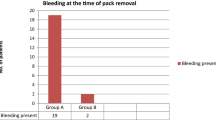Abstract
Nasal packing is routinely used after septoplasty, but there are patient factors for which its use needs to be reconsidered. Effectiveness of nasal packing in trans-septal suturing technique in septoplasty. Prospective, comparative study, patients submitted to septoplasty were randomized to receive or not nasal packing postoperatively. Comparison in postoperative status for pain, headache, discomfort in swallowing, epiphora, bleeding, infection and pain on pack removal are assessed. In all the patients trans-septal suturing technique was used. Study group has 60 patients. Two groups were made group A in whom nasal packing done post operatively with merocel, group B in whom nasal packing was not done, in both groups quilting sutures were applied on to the septum. There was pain in nose and headache in all the patients in group A. Other symptoms in group A were epiphora, discomfort in swallowing due to ear discomfort. In addition to these there is pain on removal of packs. Routine use of nasal packing can be avoided instead sutures can be placed over the septum, which benefits in improving pain and symptoms due to pack in the postoperative period.
Similar content being viewed by others
References
Bailey BJ, Goode RL, Smith LF (2001) Nasal septoplasty and submucosal resection. In: Atlas of Head & Neck Surgery, 2nd edn. chap 168, p 462
Baptistella E, Rispoli DZ, Malucelli DA et al (2008) Degree of the patient satisfaction and post-operative complications for septoplasty surgery with the use of nasal buffer. Int Arch Otorhinolaryngol 12:334–341. http://www.internationalarchivesent.org/conteudo/acervo_eng.asp?id=537
Kim MG, Baek RM, Minn KW, Heo CY, Kwon SS, Park CY (2006) Nasal packs with X-ray indicators. Ann Plast Surg 56:342–343
Lee IN, Vukovic L (1988) Hemostatic suture for septoplasty: how we do it. J Otolaryngol 17:54–56
Hari C, Marnane C, Wormald PJ (2008) Quilting sutures fornasal septum. J Laryngol Otol 122:522–523
Marshall SI, Chung F (1999) Discharge criteria and complications after ambulatory surgery. Anesth Analg 88:508–517
Fairbanks DN (1986) Complications of nasal packing. Otolaryngol Head Neck Surg 94(3):412–415
Walikar BN, Rashinkar SM, Watwe MV, Fathima A, Kakkeri A (2011) A comparative study of septoplasty with or without nasal packing. Indian J Otolaryngol Head Neck Surg 63(3):247–248
Awan MS, Iqbal M (2008) Nasal packing after septoplasty: a randomized comparison of packing versus no packing in 88 patients. Ear Nose Throat J 87(11):624–627
Korkut AY, Teker AM, Eren SB, Gedekli O, Askiner O (2010) A randomised prospective trial of trans-septal suturing using a novel device versus nasal packing for septoplasty. Rhinology 48:179–182
Jawaid A, Tahir M, Abdullah A, Akbar F, Jamalullah M (2012) Intranasal pressure splints—a reliable alternative to nasal packing in septal surgery. Bangladesh J Otorhinolaryngol 18(2):124–128
Said SM, Abdulrazzaq AF (2015) Effect of trans-septal suture technique versus nasal packing after septoplasty. Int J Tech Res Appl 3(4):33–40. e-ISSN: 2320-8163. www.ijtra.com. (July–August 2015)
Ansari MA, Islam U, Hirani I, Khayani IAM, Kashmiri ZA (2013) Trans-septal suturing technique without intra-nasal packing in nasal septal surgery. Pak J Surg 29(2):123–126
Günaydin RÖ, Aygenc E, Karakullukcu S, Fidan F, Celkkanat S (2011) Nasal packing and transseptal suturing techniques: surgical and anaesthetic perspectives. Eur Arch Otorhinolaryngol 268:1151–1156
Author information
Authors and Affiliations
Corresponding author
Ethics declarations
Conflict of interest
None.
Ethical Approval
All procedures performed in studies involving human participants were in accordance with the ethical standards of the institutional and/or national research committee and with the 1964 Helsinki declaration and its later amendments or comparable ethical standards.
Informed Consent
Informed consent was obtained from all individual participants included in the study.
Rights and permissions
About this article
Cite this article
Yadav, K., Ojha, T., Gakhar, S. et al. Effectiveness of Nasal Packing in Trans-septal Suturing Technique in Septoplasty: A Randomized Comparative Study. Indian J Otolaryngol Head Neck Surg 71 (Suppl 3), 1765–1769 (2019). https://doi.org/10.1007/s12070-017-1111-8
Received:
Accepted:
Published:
Issue Date:
DOI: https://doi.org/10.1007/s12070-017-1111-8




